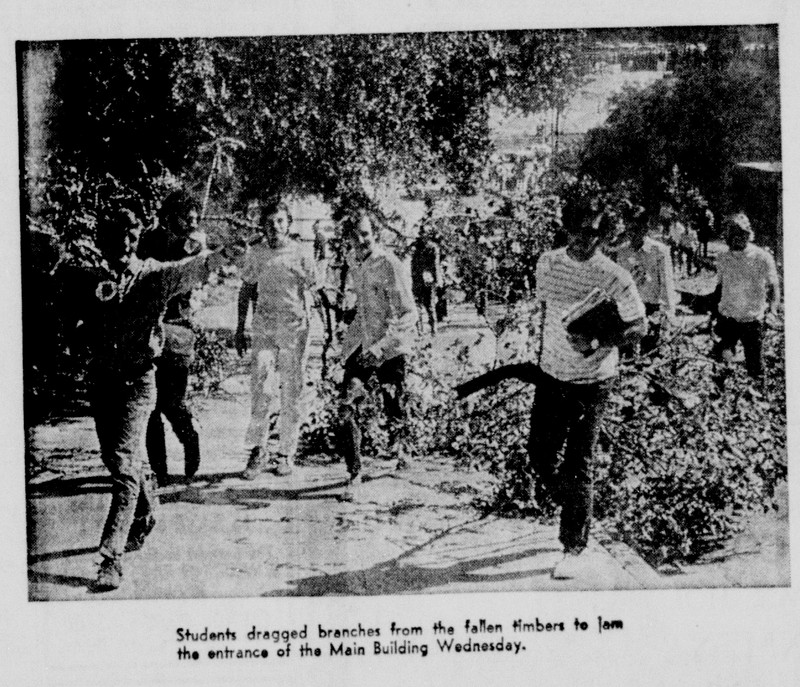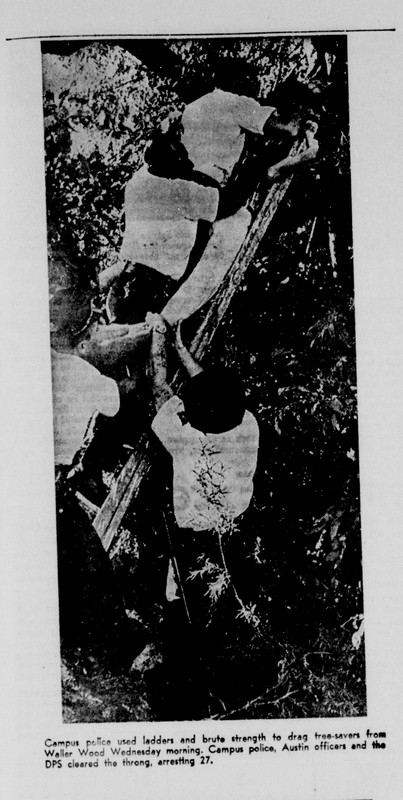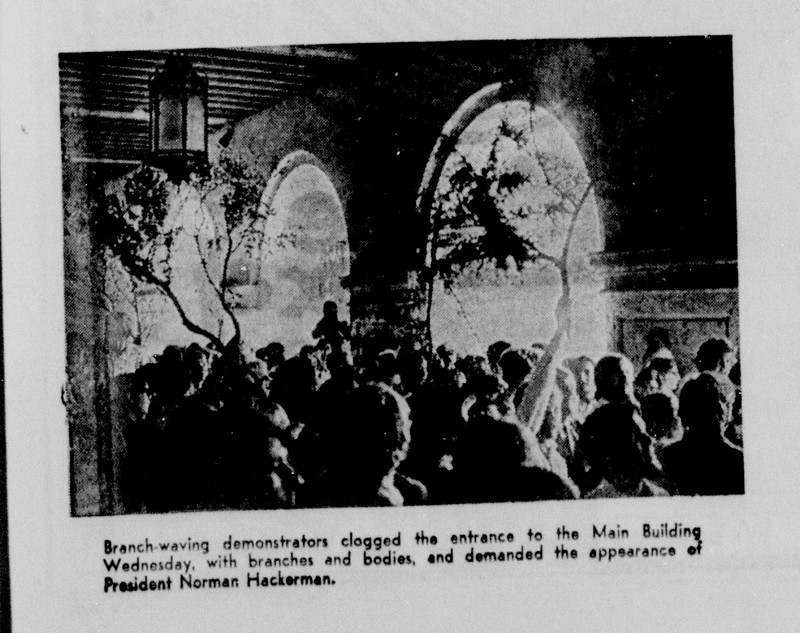Waller Creek Tree Massacre
Introduction
Text-to-speech Audio
Images
Photo taken by John Yates and published in the Daily Texan on October 26, 1969. This issue can be found in the linked database of Daily Texan archives.

Photo taken by John Yates and published in the Daily Texan on October 26, 1969. This issue can be found in the linked database of Daily Texan archives.

Photo taken by John Yates and published in the Daily Texan on October 26, 1969. This issue can be found in the linked database of Daily Texan archives.

Backstory and Context
Text-to-speech Audio
On October 22, 1969, after three days of protests, twenty-seven people were arrested as they sat in the trees, trying to prevent the bulldozing of cypress and oak trees along Waller Creek to make room for an expansion of the football stadium.
As part of the plan to expand the stadium, the administration planned to shift San Jacinto so that it would pass over Waller Creek, which, at the time, was one of the few open and green spaces on campus.[1] As part of this plan, Waller Creek would need to be straightened and narrowed and many of the trees lining it (which included live oaks and century old cypresses) would need to be removed.[2] This angered many people across campus and students in the architecture program organized against these plans in early October.[3] These landscape architecture students, joined by the architecture dean, Alan Taniguchi, created alternative plans that they published in the Daily Texan.[4] This plan would allow for the expansion of the stadium and would preserve some of the trees and landscape of Waller Creek.[5] An ecology group joined with the students to hold demonstrations against the plan of the administration.[6]
The administration agreed to meet with protesters the day before the scheduled bulldozing. The administration said it was unable to change the plans because contracts had already been signed.[7] That same night, a small group held a celebration at Waller Creek and by the next morning, several hundred people gathered at the creek. Many of these people climbed into the trees in an attempt to prevent bulldozing.[8] When Regents Chairman Frank Erwin arrived at the scene, he told the police to “Arrest as many as you need to…Get those goddamn trees down. When they are gone, the students won’t give a shit about them.”[9]
A group of people spent the late night and early morning at the site, fearing that bulldozers would come in the middle of the night to take down the trees. As police prepared to remove demonstrators from the scene, the protests climbed further up the trees.[10] The dean of students, Dr. Stephen McClellan, warned students that they were violating state and university regulations.[11] Protesters also tried blocking the bulldozers. Individuals higher up in trees were removed by a “hook-and-ladder fire truck” and policemen who climbed up after them. According to the Daily Texan, one protester only came down when three policemen “looped a leather strap in his belt” and forced him down the ladder.[12] A female student climbed to the edge of a tree limb as a policeman came after her.[13] In order to get her down, they handcuffed her ankles and one man anchored her to his belt and carried her down. She was the final protester in the trees.[14] People then tried to arrange a sit-in on San Jacinto street, but according to the Daily Texan, it was largely a failure.[15]
Later that afternoon, a rally began at the Union Patio and eventually moved to the steps of the Main Building, which holds the office of the University President.[16][17] There were about 400 students in attendance. These protesters had dragged the bulldozed trees from Waller Creek through campus and onto the steps of the Main Building, blocking the front entrance.[18][19] These students shouted, asking to meet with the University President, Norman Hackerman.[20] After two hours of negotiations, Hackerman agreed to call another meeting with the Waller Creek committee and the Board of Regents.[21] A restraining order halted the construction for about a week, but then construction resumed.[22]
In general, the new left was critical of the culture of capitalism and this was the lens with which they approached questions of ecology.[23] They saw ecological concern as a criticism of corporate capitalism and the impact it had on the physical world.[24] They saw the power elite as the biggest polluters of both society and the environment.[25] The new left believed that the people who repressed political dissent on campus, the people who bulldozed the trees, the people that ran the oil companies, the people who wanted Americans to buy more cars, and the people who built cities for their own profit were fundamentally the same and all saw “everyone and everything but themselves as resources to be exploited for profit.”[26] The new left found a new form of violence - environmental violence - “that seemed like a war against the world itself, and thus against all its inhabitants.”[27]
Not long after the events at Waller Creek occurred, an Ecology Action chapter formed in Austin. This group organized around Earth Day in early 1970. Ecology Action also set up the first recycling operations in Austin, distributed information about organic food, and talked about other methods of preventing environmental degradation.[28] They wanted to continue exposing corporations and the power elite, but they also wanted to change common attitudes and behaviors within the community.
Sources
[2] Rossinow, The politics of authenticity.
[3] Rossinow, The politics of authenticity.
[4] Rossinow, The politics of authenticity.
[5] Rossinow, The politics of authenticity.
[6] Rossinow, The politics of authenticity.
[7] Rossinow, The politics of authenticity.
[8] Rossinow, The politics of authenticity.
[9] Rossinow, The politics of authenticity.
[10] Rossinow, The politics of authenticity.
[11] Rossinow, The politics of authenticity.
[12] Patsy Guenzel, "Erwin Urges Workmen On at Levelling," The Daily Texan (Austin, TX), October 23, 1969.
[13] Guenzel, "Erwin Urges Workmen On at Levelling."
[14] Guenzel, "Erwin Urges Workmen On at Levelling."
[15] Guenzel, "Erwin Urges Workmen On at Levelling."
[16] Ruth Doyle, "Cut Timber Barricades Main Door," Daily Texan (Austin, TX), October 23, 1969.
[17] "The Trees of Texas are Upon You," Daily Texan (Austin, TX), October 26, 1969.
[18] Doyle, "Cut Timber Barricades Main."
[19] "The Trees of Texas." [20] Doyle, "Cut Timber Barricades Main."
[21] Doyle, "Cut Timber Barricades Main."
[22] http://www.utwatch.org/archives/universityinc.html
[23] Douglas C. Rossinow, The politics of authenticity: Liberalism, christianity, and the new left in america (New York: Columbia University Press, 1998).
[24] Rossinow, The politics of authenticity.
[25] Rossinow, The politics of authenticity.
[26] Rossinow, The politics of authenticity.
[27] Rossinow, The politics of authenticity, [Page 276].
[28] Rossinow, The politics of authenticity, [Page 277].
